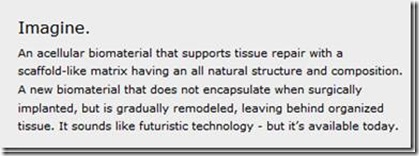Last year I had a lengthy interview with Cook Medical that describe in detail how hernia repair works and the studies are now showing the graft is out performing a  straight synthetic mesh. The material is derived from the small intestine of pigs and communicates with the body, signaling surrounding tissue to grow across the scaffold, which in turn allows the body to naturally restore itself. Historically, surgical procedures have involved using plastic or synthetic repairs. These types of non-natural devices, however, often do not mesh well with the human body and thus are always a foreign product. Cook’s product enables the natural reproduction of human tissues and the biologic repair becomes a natural, functioning part of the body. BD
straight synthetic mesh. The material is derived from the small intestine of pigs and communicates with the body, signaling surrounding tissue to grow across the scaffold, which in turn allows the body to naturally restore itself. Historically, surgical procedures have involved using plastic or synthetic repairs. These types of non-natural devices, however, often do not mesh well with the human body and thus are always a foreign product. Cook’s product enables the natural reproduction of human tissues and the biologic repair becomes a natural, functioning part of the body. BD
Regenerative Medicine and How it Works – Interview with Cook Biotech (Medical)
Press Release:
Clinical Study: Biologic Grafts Reduce Postoperative Pain While Creating a Repair as Durable as Synthetic Mesh in Treating Inguinal Hernias
Cook Medical’s Biodesign™ Inguinal Hernia Graft outperforms synthetic mesh in double-blind study published in the American Journal of Surgery
Bloomington, Ind., February 9, 2010 – Results from a clinical study led by Luca Ansaloni, M.D., showed that Cook Medical’s Biodesign Inguinal Hernia Graft causes less postoperative pain and discomfort while creating a repair as durable as synthetic mesh when used in Lichtenstein’s hernioplasty procedures. As published in a recent issue of the American Journal of Surgery, the three-year, 70-patient study determined that patients treated with Biodesign Inguinal Hernia Graft experienced a lower level of postoperative pain as compared with synthetic mesh-based procedures.
The randomized, double-blind inguinal hernia study examined the efficacy of the Biodesign Inguinal Hernia Graft in treating 35 men compared to 35 men treated with synthetic mesh. Research findings showed that 11 percent of patients treated with synthetics experienced chronic postoperative pain that limited daily activities, most often resulting from the mesh characteristics as opposed to surgical technique. By contrast, patients in the study treated with Biodesign Inguinal Hernia Graft experienced a lower degree[1] of postoperative pain both at rest and when coughing or moving. Additionally, a three-year follow-up no evidence of hernia recurrence was seen in the study patients treated with the Biodesign graft.
Inguinal hernias occur when soft tissue, generally part of the intestine, forces its way through a tear in the lower abdominal wall or through the inguinal canal and creates a bulge that can be painful when coughing, bending or lifting heavy objects. According to the NIH, inguinal hernias are more common in men and often develop as a result of the frequent heavy lifting, coughing or straining. While hernias aren’t necessarily dangerous themselves, they can lead to life-threatening conditions if left untreated.
“Based on our research findings, biologic grafts are extremely effective when treating inguinal hernias,” said Dr. Ansaloni, a general surgeon at St. Orsola-Malpighi University Hospital in Bologna, Italy. “Not only did [study] patients recover quickly after receiving the Biodesign Inguinal Hernia Graft, but they experienced less pain
and discomfort as compared to patients who were treated with synthetic mesh.”
The Biodesign Inguinal Hernia Graft incorporates attributes of a biologic graft – resistance to infection and complete remodeling – with the added benefits of moderate price, ease-of-use and ample shelf life for on-site availability. Upon deployment, the graft reinforces the repair of surrounding tissue and, over time, communicates with the patient’s body, signaling surrounding tissue to grow across the scaffold where the repair is needed. The Biodesign Inguinal Hernia Graft is designed specifically for reinforcing the inguinal floor and designed to meet special challenges including resistance to infection[2], encapsulation and erosion.
“The potential complications associated with the use of synthetic mesh in treating inguinal hernias can cause a significant decrease in quality of life for patients while also increasing procedural recovery time,” said Andy Cron, vice president of Cook Medical’s surgery strategic business unit. “This study comes at a very important time, as the medical field continues to debate the benefits of biologic and synthetic treatment options. Dr. Ansaloni’s research reinforces our efforts to leverage biologic solutions that provide hernia patients with a natural, lasting solution.”
About Cook Medical
Founded in 1963, Cook Medical pioneered many of the medical devices now commonly used to perform minimally invasive medical procedures throughout the body. Today, the company integrates medical devices, drugs and biologics to enhance patient safety and improve clinical outcomes. Since its inception, Cook has operated as a family-held private corporation. For more information, visit www.cookmedical.com.
[1] American Journal of Surgery 2009. L. Ansaloni, F.Catena, F. Coccolini, F. Gazzotti, L. D’Alessando, Pinna AD.
[2] Arch. Surg. 2005 June: 140(6):549-60. Helton WS, Fisichella PM, Berger R, et al




0 comments :
Post a Comment